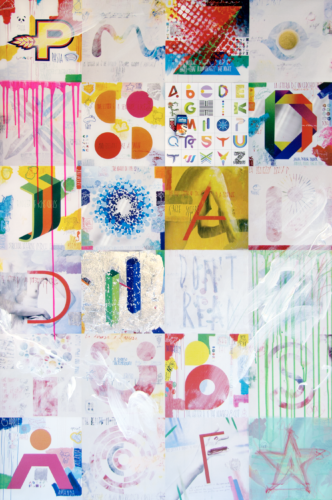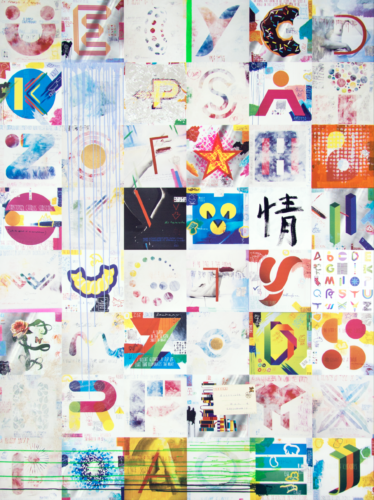[English version below]
Lorenzo Marini e’ un poeta antico che ti incanta con il sussurro soave della sua voce, con parole che evocano visioni docili e immagini che risvegliano dolci sentimenti. Lorenzo e’ artista e scrittore, ma anche pubblicitario. Usa i colori velati dal bianco, disegna griglie di architetture immaginifiche che spariscono nel bianco come civilizzazioni passate coperte dalla sabbia, costruisce cubi trasparenti dai colori sgargianti con intagli di lettere.
Lorenzo e’ un esploratore dei tempi moderni. Studente di architettura all’Academia di Venezia, ha goduto le lezioni di uno dei maestri dell’Arte Informale Emilio Vedova ed e’ oggi riconosciuto icona del mondo della pubblicita’, mondo che ha abitato per trent’anni. Durante gli ultimi due decenni, ha creato perlopiu’ dietro il velo della sua stessa storia, in silenzio e discosto dal rumore della fama, opere d’arte leggere ed evocative degli SpaceVisual e AdVisual. Ed ancora, dall’evocazione e l’emozione la sua esplorazione e’ passato all’analisi e concettualizzazione dei Typevisual per i quali scrisse un Manifesto, come Lucio Fontana, un altro artista informale come Vedova, fece nel 1946 con il Manifesto Bianco per definire l’integrazione tra arte e scienza e come fece nel 1909 Marinetti per il movimento futurista per celebrare macchinari e velocita’.
Non e’ un caso che l’ulteriore rappresentazione delle lettere sono le Futuretype in chiaro stile futurista.
Ma ecco che se si guarda alle opere di Lorenzo, altri sono i riferimenti agli storici movimenti artistici e ai capisaldi di alcuni di essi. Un po ‘di Twombly così come le tele rugose e l’uso di una varietà di elementi extrapittoriali di Piero Manzoni in SpaceVisual e AdVisual, un po’ di Basquiat con le parole inscritte nel quadro, dell’e’criture automatique dei surrealisti in quell’elencare per libera giocosa associazione parole diverse che iniziano con la stessa lettera perche’ donut, dolphin, drums, Dublin e non donna, diavolo, dono, denti per esempio? Ed anche la pop art di Warhol, anche lui pubblicitario, che vuole offrire a chiunque la possibilita’ di relazionarsi all’opera d’arte in una rivoluzione democratica del vedere e fare arte, o anche il ready made e Dada di Duchamp che sciocca il perbenismo della societa’ del consumo, altro riferimento alla liberazione delle lettere dalla schiavuta’, inno del manifesto mariniano. E infine, perche’ non riconoscere l’eredita’ biblica dell’”inizio fu il verbo”? L’opera di Lorenzo e’ fantascientifica nel suo essere rottura delle lettere dalla gabbie di parole significanti ma anche antropologica nel suo ritornare alle immagini che aiutano a comprendere la parole, come nel medioevo quando le chiese si adornavano di scene dipinte per illustrare agli analfabeti il significato delle Scritture, per non menzionare i primordi della civilta’ quando ancora i linguaggi non erano stati creati ma concetti e storie erano freschi nelle caverne.
L’esploratore Lorenzo Marini si e’ avvicendato nella solitudine dell’artista e ha invitato lo spazio degli altri, specialmente creato in architettura, in quel mondo individualista, con l’impatto di uno spazzaneve che apre un varco tra il bianco soffice e silenzioso dei fiocchi di neve accumulatesi sul terreno. Forse anche questa e’ una sua rivoluzione.
In tutto questo, lo spirito affabulatore del pubblicitario non e’ mai veramente stato disconnesso e le sue ultime opere sono quei cubi in cui Lorenzo ci invita ad ammirare le lettere come il ragno che agilmente ha costruito la sua tela. Dall’interno di quei cubi non possiamo più ammirare il silenzio del cielo dove Costellazioni mappano l’universo con forme evocative. L’umanità è ora privata della meraviglia del significato della vita interpretando le stelle (nei dipinti di Lorenzo ora simboli in un linguaggio stellato) ed è intrappolato nella cacofonia dei suoni. (LH)
[English version]
Lorenzo Marini is an ancient poet who enchants you with the soft whisper of his voice, with words that evoke docile visions and images that awaken sweet feelings. Lorenzo is an artist and writer, but also an advertiser. He uses the colors veiled by white, draws grids of imaginative architectures that disappear in the white like past civilizations covered by sand, builds transparent cubes with bright colors with letter carvings.
Lorenzo is an explorer of modern times. Architecture student at the Academy of Venice, he enjoyed the lessons of one of the masters of Informal Art Emilio Vedova and is now recognized as an icon of the world of advertising, a world that he has lived in for past thirty years. During the last two decades, he has mostly created behind the veil of its own history, in silence and devoid of the noise of fame, light and evocative works of art of the SpaceVisual and AdVisual. And again, from the evocation and emotion his exploration has passed to the analysis and conceptualization of the Typevisuals for which he wrote a Manifesto, as Lucio Fontana, another Informal Artist like Vedova, did with the Manifesto Bianco in 1946 to define the integration of art and science and as Marinetti did in 1909 for the Futurist movement to celebrate machinery and industry. It is no coincidence that the further representation of the letters is the Futuretype in clear Futurist style.
But here is that if you look at the works of Lorenzo, others are the references to the historical artistic movements and to the cornerstones of some of them. A bit of Twombly as well as the wrinkled canvases and the use of a variety of extrapictorial elements of Piero Manzoni in SpaceVisual and AdVisual, a bit of Basquiat with the words inscribed in the painting, the e’criture automatique of the surrealists in that list by free playful association of different words that start with the same letter why donut…. .and not diamonds, devil, demands, for example? And also Warhol’s pop art, he too an advertising man, who wants to offer anyone the chance to relate to the work of art in a democratic revolution of seeing and making art, or even Duchamp’s ready-made and Dada fooling the respectability of the consumer society, another reference to the liberation of letters from slavery, the hymn of the Marinian manifesto. And finally, why not recognizing the biblical heritage of the “beginning was the verb”? Lorenzo’s work is science fiction in his being the breaking free of the letters from the cages of significant words but also anthropological in his return to the images that help to understand the words, as in the Middle Ages when the churches were adorned with painted scenes to illustrate to illiterates the meaning of the Scriptures, not to mention the beginnings of civilization when languages were not yet created but concepts and stories were frescos in the caves.
The explorer Lorenzo Marini has come and gone in the solitude of the artist and invited the space of others, especially created in architecture, in that individualistic world, with the impact of a snow plow that opens a gap between the soft and silent white of snowflakes accumulated on the ground. Perhaps this is also his revolution. In all this, the storyteller spirit of the advertiser has never really been disconnected and his last works are those cubes in which Lorenzo invites us to admire the letters like the spider who easily built his canvas. From within those cubes we can not anymore admire the silence of the sky where Constellations map the universe with evocative shapes. Mankind is now deprived of the wonderment of the meaning of life by starring at the stars (in Lorenzo’s paintings now symbols in a starry language) and is trapped in the cacophonie of sounds. (LH)

